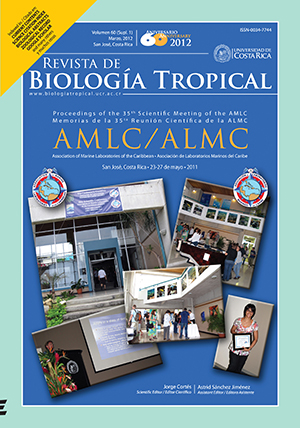Abstract
Quick, reliable and non destructive methods are necessary to estimate size structure on commercial land crabs, in order to acquire relevant information concerning the health of their populations. Cardisoma guanhumi and Ucides cordatus are two land crabs that are exploited at a high scale and also in an artisan way in the Caribbean area and in the coasts of Brazil, which populations are endangered due to uncontrolled exploitation. The purpose of this work is to provide various methods to estimate indirectly crab body size. Sampling was carried out in Carenero (C. guanhumi) and Cumaná (U. cordatus) (Venezuela). For each species, three methods were used to measure burrow diameter (Vernier, internal spring caliper and photograph), and these were correlated with real body size of the crabs. Model II linear regression analyzes, i.e. Ordinary Least Squares and Mayor Axis, were used to build and test the performance of forecasting models. Cardisoma guanhumi showed a high bivariate data dispersion using Vernier and photo measuring methods, increasing these towards larger animals. Less dispersion was achieved with the spring caliper method; this resulted in the most accurate measurements of indirectly estimated body size in C. guanhumi (r2= 0.61), whereas Vernier measurements were the least precise. On the other hand, all three methods gave reliable estimates for U. cordatus, being the Vernier method the most accurate (r2= 0.71). However, in both species, all forecasting equations overestimated the size of smaller crabs (those below the mean) but underestimated the size of larger crabs. Nevertheless, all three methods were statistically significant for each of the species, and looking at the above mentioned under- and overestimations, they can serve as reliable and fast non-destructive tools to be used by resource managers and field biologists to acquire size structure information concerning these two species. Vernier and internal spring caliper methods are recommended for relative small sampling areas, while photo method is suggested to be used in very extensive sampling regions.Comments
Downloads
Download data is not yet available.






